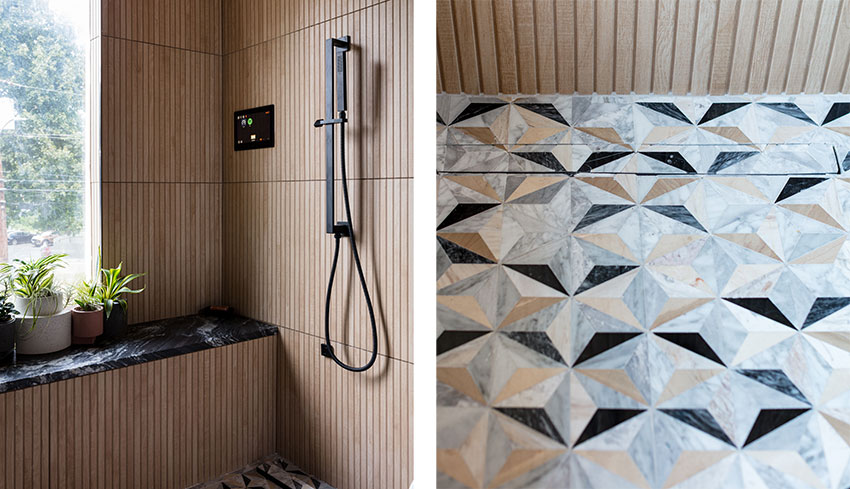Understanding Architectural Linear Drains
In response to this critical need, at least one manufacturer offers linear drain products that utilize a double waterproofing method combined with a factory-applied waterproof membrane fabric. It is readily compatible with traditional waterproofing methods like vinyl, lead/copper pan, or hot mop underneath, allowing the bonded fabric method to function as the first line of defense above. This saves installers time on the job. It also provides some assurance of performance since both the drain manufacturer’s and membrane manufacturer’s warranties apply.
Other Considerations
There are a few other things that can come into play when making design decisions about architectural drainage systems. As noted earlier, there are prefabricated sloped metal pans available that can streamline the installation of a sloped floor and drainage system. The size and slope options should be verified with a manufacturer, but in some cases, using this available product can mean less construction time and cost than traditional installations of flooring and deck surfaces. Manufacturers should be consulted for lead times on different products, particularly if customization is needed. Generally speaking, fast turnaround times are possible but always subject to change.
LINEAR DRAINS IN BUILDING APPLICATIONS
With an understanding of the principles and aspects of architectural linear drains, we can now focus on different types of building applications and project examples.
Commercial Building Applications
Commercial buildings are often high-use areas that require durability and accessibility. At the same time, the interior design of these buildings often needs to be high quality to be consistent with the image or appearance that the building owner or tenant is seeking to convey. Further, it needs to preserve that quality over time by being easy to clean and maintain.
Residential Building Applications
Residential projects may not need to be quite as heavy-duty as commercial ones, but clients and owners still seek higher levels of design and quality. In some ways, these projects, whether single-family or multifamily, can be more personal and fully customizable. This is true not only for aesthetic design but for functional design too. There has been a growing interest in residential design that allows for “aging in place” as a desirable long-term feature, thus increasing the significance of accessibility as residents grow older.
Indoor Applications
There are many interior locations besides bathrooms that can be logical places to use architectural drains. The general versatility of these products means they can be used anywhere. Some typical examples include commercial kitchens, laundry rooms, indoor pools, spa areas, locker rooms, exercise rooms, and other places where water may need to be drained away discreetly but effectively. A sometimes-overlooked place is an elevator pit which typically needs integral drainage. It can be equally important to include architectural linear drains in front of elevator doors. That way, if the fire sprinklers are activated, the sprinkler water can be collected and drained away, keeping it out of the elevator shaft and allowing first responders to function unencumbered.
Outdoor Application
Outdoor spaces often need to drain away rainwater, snow melt, irrigation water, or excess swimming pool water. That means that outdoor locations such as terraces, pool areas, balconies, and decks may all benefit from architectural linear drains. The same is true for paths of travel for pedestrians and/or vehicles.
CONCLUSION
Specifying architectural linear drains in a building project can provide appealing, well-performing solutions for many different applications. Successful design begins by understanding the nature and type of architectural drains available, including the options for design and performance characteristics. Then, all of the areas that require drainage can be assessed for sizing and type, including indoor and outdoor spaces. The combination of design and performance makes for successful drainage solutions in different building types and settings. It is abundantly clear that architectural linear drainage systems provide a design option that improves the overall, integrated appearance of drains while still meeting all of the needed code, performance, safety, and operational needs of different types of projects.











